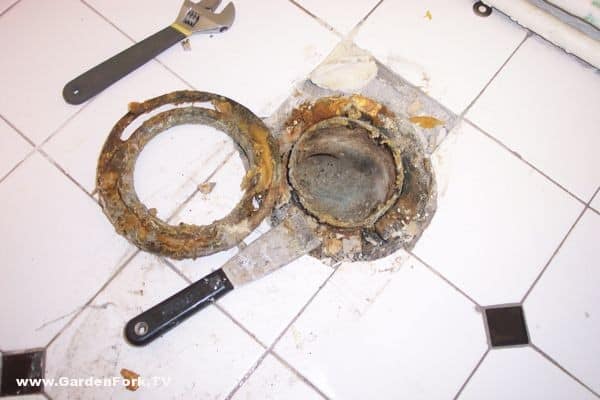How do you feel about How to Replace a Toilet Flange?

Intro:
Recognizing the Importance of a Toilet Flange:
In the realm of plumbing, the often-overlooked toilet flange plays a critical duty in making certain the seamless procedure of your bathroom fixtures. Acting as an important port in between your bathroom and the underlying drain, the commode flange serves as the unrecognized hero of your plumbing system. Without this durable element, your bathroom would be prone to instability and leaks, potentially causing expensive repair services and aggravation. Therefore, comprehending the significance of a properly installed and maintained toilet flange is paramount for any kind of home owner embarking on plumbing projects or addressing repair demands.
Why Proper Installation and Maintenance Matter:
Correct installment and careful maintenance of the toilet flange are essential for securing the stability of your plumbing infrastructure. A meticulously installed flange not just supports your toilet securely in position however additionally develops an impenetrable seal, warding off the risks of leakages and odours. By embracing an aggressive technique to flange upkeep, you can reduce the risk of turbulent plumbing problems and preserve the serenity of your family environment. Throughout this informative overview, we'll unravel the intricacies of commode flange setup and repair work, encouraging you with the understanding and knowledge to navigate these necessary tasks expertly.
Ideal Practices When Installing a Toilet Flange:
Guaranteeing a seamless bathroom flange installation calls for adherence to a set of ideal practices that assure sturdiness and performance. Begin by carefully assessing your devices and materials, ensuring you have the essential devices for the work ahead. Selecting the proper flange material, whether PVC, ABS, or cast iron, is vital, as it determines the durability and efficiency of your plumbing fixture. In addition, assessing existing plumbing problems, such as looking for damage or rust, is essential for preemptively attending to possible complications and guaranteeing a smooth installation procedure. By embracing these primary measures, you set a strong foundation for a successful bathroom flange installment, minimising the possibility of future concerns and helping with long-lasting upkeep.
Once sufficiently ready, wage the careful removal of the old flange, complying with an organized method to prevent creating damages to surrounding components. Utilize methods customized to resolve stubborn or rusted flanges, guaranteeing their swift and secure removal without compromising the stability of the surrounding plumbing facilities. With the old flange got rid of, diligently mount the new replacement flange, choosing one that fits comfortably and safely right into area. Effectively safeguarding the flange to the flooring making use of screws or adhesive is crucial, as it makes sure security and stops future leakages. By sticking to these finest methods during the setup process, you lay the groundwork for a robust and reputable toilet flange configuration that stands up to the examination of time.
Mounting a New Toilet Flange:
When installing a new toilet flange, the very first step is to pick the right replacement for your plumbing setup. Consider elements such as the material of the flange, with choices including PVC, ABS, or cast iron. PVC flanges are understood for their cost and resistance to deterioration, making them a preferred selection for DIY fanatics. Abdominal muscle flanges supply comparable advantages to PVC yet brag included toughness, making them ideal for high-traffic locations or business setups. Cast iron flanges, renowned for their toughness and durability, are suitable for setups where toughness is vital. Furthermore, ensure that the replacement flange is properly sized and fits snugly right into location to create a watertight seal and protect against leakages.
Protecting the Flange to the Floor:
Once you've chosen the right substitute flange, it's crucial to protect it properly to the floor to make sure stability and prevent future concerns. Begin by positioning and straightening the flange properly over the waste pipe, making certain that it sits flush with the flooring surface. Relying on the kind of flange and your specific setup preferences, you can safeguard the flange to the floor making use of screws or adhesive. If making use of screws, be sure to make use of corrosion-resistant options to stop rusting over time. Conversely, adhesive can offer a safe and secure bond between the flange and the flooring, ensuring a strong and dependable setup. By following these steps and taking the essential safety measures, you can mount a new bathroom flange with self-confidence, guaranteeing a resilient and leak-free plumbing fixture.
Best Practices When Repairing a Broken Flange:
Fixing a busted toilet flange needs thorough attention to information and adherence to ideal practices to make sure an enduring solution. Begin by completely examining the level of the damage and determining the underlying reason, whether it be deterioration, cracks, or misalignment. This examination will certainly guide your repair work method, permitting you to pick the most suitable methods and products for recovering the flange to its optimum problem. Additionally, consider the surrounding plumbing facilities and flooring security to attend to any kind of possible adding variables and prevent future issues from occurring. By carrying out a detailed evaluation and evaluation, you prepared for an efficient and long-lasting repair service process that solves the origin of the trouble.
With a clear understanding of the flange's problem and the variables affecting its damages, wage the repair service procedure utilizing accuracy and care. Depending on the severity of the damages, you might select repair service techniques such as epoxy putty, repair work flange kits, or partial flange replacements. Ensure that the chosen repair approach properly resolves the certain concerns handy while keeping the architectural honesty and capability of the flange. In addition, take aggressive actions to enhance the fixed flange and protect against future damages, such as using sealer or waterproofing products to protect against leaks and corrosion. By adhering to these best practices during the repair procedure, you can recover your busted flange to ideal condition, guaranteeing the long-term reliability and performance of your plumbing system.
Sorts Of Toilet Flanges:
Recognizing the numerous kinds of bathroom flanges is important for picking one of the most ideal choice for your plumbing needs. PVC, ABS, and cast iron are among the usual products utilized in toilet flange construction, each offering distinctive advantages and considerations. PVC flanges, known for their price and rust resistance, are favoured for their simplicity of installation and durability. Abdominal muscle flanges, comparable to PVC in terms of price and simplicity of installation, are treasured for their toughness and resistance to effects. On the other hand, cast iron flanges, renowned for their remarkable toughness and durability, are frequently preferred for high-traffic locations or industrial setups where sturdiness is critical. By acquainting yourself with the characteristics of each product, you can make an informed choice when choosing a commode flange that lines up with your specific demands and preferences.
Along with material factors to consider, toilet flanges additionally come in numerous styles and designs to suit different plumbing setups and installation choices. Offset flanges, for example, are created to accommodate commodes installed on floorings that are uneven or where the waste pipe lies off-centre. Similarly, repair service flanges, also referred to as fixing rings or spacer rings, are utilized to resolve issues such as fractured or broken flanges without the requirement for considerable plumbing adjustments. Furthermore, flexible flanges provide versatility ready, allowing for exact alignment and fit during installment. By exploring the diverse range of commode flange kinds and layouts available, you can choose the option that best suits your plumbing setup and installation requirements, ensuring a seamless and dependable service for your shower room fixtures.
Specialized Options:
Along with typical commode flanges, there are specialized alternatives readily available to resolve details plumbing obstacles and installment choices. One such choice is the balanced out flange, which is developed to accommodate toilets mounted on floors that are not level or where the drain lies off-centre. Balanced out flanges feature a distinct design that permits the commode to be placed at a small angle, compensating for irregular floor covering or misaligned plumbing links. This ingenious solution ensures a safe and secure and steady setup, eliminating the demand for costly and taxing floor leveling or pipeline relocation. By incorporating a countered flange into your plumbing setup, you can get over typical installation barriers and accomplish a professional-quality result effortlessly.
One more specialty alternative worth thinking about is the repair flange, additionally referred to as a fixing ring or spacer ring. Repair flanges are particularly designed to resolve problems such as cracked or damaged toilet flanges without the demand for extensive plumbing adjustments. These flexible parts can be installed directly over the existing flange, offering a strong and reliable base for safeguarding the toilet in position. Repair flanges come in different dimensions and setups to suit different flange sizes and installation demands, making them a practical and cost-effective remedy for solving flange-related problems. Whether you're managing a minor flange repair or an extra complex plumbing concern, integrating specialty alternatives like offset and fixing flanges can enhance the installation process and ensure resilient performance for your washroom fixtures.
Verdict:
To conclude, understanding the art of bathroom flange installment and repair work is crucial for preserving a useful and leak-free plumbing system in your home. By recognizing the significance of an effectively set up flange and sticking to best methods throughout the process, you can make sure the durability and integrity of your washroom fixtures. Whether you're selecting the best kind of flange, carrying out repair services, or discovering specialized alternatives, focus to information and meticulous execution are vital. Normal upkeep and aggressive repairing can aid prevent costly plumbing issues and preserve the serenity of your home atmosphere. Armed with the understanding and skills acquired from this extensive guide, you can tackle toilet flange installation and repair with confidence, encouraging you to guard your plumbing system for several years ahead.
How to Replace a Toilet Flange
The toilet flange is the part that keeps your toilet attached to the drain. A broken toilet flange will result in your toilet moving around and can even cause it to leak.
A broken toilet can be such a headache and the leaking water can even cause further damage. Many people don’t know about the different elements of replacing a toilet or fitting a new toilet, and it’s important to know these skills when you’re a homeowner.
This article will walk you through how to quickly and correctly do a toilet flange repair.
How to Replace a Toilet Flange
A toilet flange is a critical element of a toilet, but it serves two separate functions. For instance, a toilet flange secures your toilet unit onto the ground and connects the toilet bowl to the wastewater line.
Often, a toilet flange is already in place when installing a toilet, so many homes have these features but never think of them until they are broken. Therefore, you need to know when to replace a toilet flange.
Remove the Toilet
The first stage is removing the toilet and disconnecting the structure from the water supply. You can close the knob at the back of the toilet and empty the toilet tank several times.
After this, you should remove the water hose from the toilet. It’s essential to cover your bathroom floor with newspaper or a tarp to ensure there’s no external damage to your space.
This can be a complicated process, so getting professional help may be necessary if you don’t feel confident about replacing a toilet flange. When you work with an experienced professional, you can ensure the job is done correctly.
Unscrew Two Nuts and Bolts
The two nuts and bolts are the parts that hold the toilet to the flange and floor, so you need to tackle this part next. You can use an adjustable wrench if the nuts are secure and too tight.
After this, you can set the nuts aside in a container and reattach the toilet when the flange is completely repaired.
Remove the Old Wax
Next, after you’ve removed the toilet and nuts and bolts features, you should remove the old wax that sealed the toilet to the flange. You can quickly eliminate the old wax with a putty knife or other similar tool.
Work your way down the build-up of old wax until you reach the top of the toilet flange.
Remove the Flange
Once you reach the flange structure, you can search for the screws outside the part. All you need to remove the screws is a multi-head screwdriver, allowing you to remove different screws.
You can remove the flange and clean it with disinfectant or a wipe to sanitize the surface area. It’s also a good idea to stuff an old towel or cloth into the space to prevent odors and gasses from oozing from the area.
This is where you need to measure the diameter of the outflow pipe’s mouth to find the identical part to replace the toilet flange. You must have exact measurements when searching for a new flange.
Otherwise, you will buy a new toilet flange that can be used in your bathroom.
You can also take the old toilet flange in a secure bag to your local hardware shop if you want to make a direct comparison with a new product. You must also buy sealing wax for the new toilet flange.
If you need help buying a new toilet flange, a professional plumber can help or an employee at your local store.
Apply New Flange and Fit Toilet
At this point, you can fit the new toilet flange following the instructions given with the product, or you can hire a professional to do the job for you. You should also apply the new seal wax around the mouth.
This will allow the toilet flange to stay in place and not become broken again shortly.
Finally, you can fit the toilet structure back in place by securing the nuts and bolts again. You should reattach the water supply and test the flush to check that the water is running correctly.
To test the water supply, you can flush the toilet several times and wait for the water to fill up and empty repeatedly.
The last step is to tidy the bathroom space and clear away the dirty towels or newspapers. It’s a good idea to clean the floors with a strong disinfectant to eliminate the odors left behind.
With experience, you can fix the toilet flange in no time. But, if you’ve never handled these toilet parts, you should hire a professional plumber to take care of them.
Thankfully, our team is here for you. We have the best plumbers in Detroit to help you fix any toilet issues you encounter at home.
https://waterworkplumbing.com/how-to-replace-a-toilet-flange/

We had been guided to that report on How to Repair a Toilet Flange through an acquaintance on a different web blog. You should take a moment to promote this write-up if you enjoyed reading it. We take joy in your readership.
Detail
 Emilio Estevez Then & Now!
Emilio Estevez Then & Now! Jaleel White Then & Now!
Jaleel White Then & Now! Patrick Renna Then & Now!
Patrick Renna Then & Now! Tatyana Ali Then & Now!
Tatyana Ali Then & Now! Michael Fishman Then & Now!
Michael Fishman Then & Now!